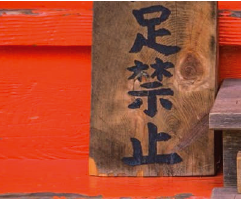Japan dos and don'ts: Etiquette tips for first-time travellers
Japan dos and don'ts: Etiquette tips for first-time travellers
Japan is warm and welcoming to travellers, but its culture can be confusing for the first-time visitor. To help create a stress-free journey, get familiar with a few of these handy tips before your trip.
Meeting and greeting
Bow politely when you meet someone, thank them, or say goodbye. If a Japanese person bows to you, an incline of the head will usually be enough. Japanese do sometimes also shake hands, but it’s best to wait for them to offer their hand. The exchanging of business or name cards is still an important part of more formal introductions in Japan. You should use two hands when giving and receiving cards. This also goes for giving and receiving gifts.
Shoes off
If there are rows or shelves of footwear by the door of a building or room, it’s a clear sign you’re expected to remove your shoes. You’ll always have to remove footwear when entering a private home and temple halls. Some restaurants, hostels and historic sites with carpets will also require visitors to take off their shoes. Wherever you’re required to remove footwear, this is non-negotiable.
Eating and drinking
There are a number of dos and don’ts related to the use of chopsticks. The main ones to keep in mind are to not leave chopsticks standing upright in a bowl of rice, or in a bottle or glass. Also avoid anything that might be considered ‘playing’ with your chopsticks (this includes using them as a spear, drumming on the table, waving them to get the waiter’s attention, and using them to get at that itch on your back). When eating noodles in Japan, it’s standard practice to slurp them. Eat in any noodle restaurant and you’ll be surrounded by diners noisily slurping away. There is no custom of tipping in Japan. Leaving a little extra cash on the table at a restaurant will often result in a waiter chasing you down the street to give it back.
Visiting temples and shrines
There are many, many temples and shrines across Japan and most are open and welcoming to visitors, whether or not you’re a believer. But these are still religious sites: speak quietly in the main halls, don’t poke around cordoned-off areas, and avoid dressing as though you’re out for a day at the beach. There will be a water source in front of any shrine. Before entering the shrine wash your hands and pour water into your hand to rinse your mouth (spit out on the ground, not back into the water source).
Public behaviour
Quiet, please. It’s rude to speak on your mobile phone while on trains and buses, and announcements encourage travellers to switch phones to silent mode. People also tend not to speak loudly when travelling on public transport, so as not to disturb other passengers. At busy times when waiting to board a train, Japanese form a queue. Train station platforms will have markings showing where the carriage doors will pull up, and may have lines drawn on the platform to guide the direction of the queues. It’s rude to blow your nose in public. You may also see people walking around wearing surgical-style masks – some choose to use these when they have cold or flu to prevent passing on their ailment to others.

